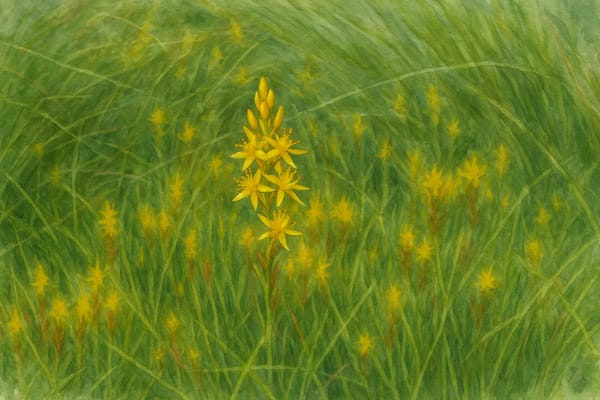Bog Asphodel (Narthecium ossifragum)
A wild beauty of Cornwall’s wetlands, Bog Asphodel brings folklore, golden blooms, and pollinator value to damp coastal gardens. Thrives in acidic, wet soil and echoes the resilience of the moors.


A wild beauty of Cornwall’s wetlands, Bog Asphodel brings folklore, golden blooms, and pollinator value to damp coastal gardens. Thrives in acidic, wet soil and echoes the resilience of the moors.


With its golden flower spikes glowing among the mists of Cornwall’s bogs and moors, Bog Asphodel has long been woven into folklore, symbolism, and rural tradition.
Bone-Breaker Lore
Its Latin name, ossifragum — meaning “bone-breaker” — comes from an old belief that livestock grazing near the plant developed brittle bones. The truth lay in the calcium-poor soils of moorlands, not the plant itself, but the warning became folklore wisdom passed through generations.
Magical and Protective Uses
In Cornwall, Dartmoor, and further afield, Bog Asphodel was believed to ward off evil, and sometimes featured in fertility or purity rituals. Its fibrous leaves were used for thatching and weaving, linking the plant to resourceful rural life.
Artistic Symbol
Bog Asphodel has inspired poets and painters, often used to capture the resilience and beauty of Britain’s untamed wetland landscapes. Its bright colour stands out in the sombre tones of the moor, becoming a symbol of survival and wildness.
Ecological Indicator
More than folklore, Bog Asphodel is also a vital ecological marker, signaling healthy peat bogs and moorland. Its flowers feed pollinators, and its presence reflects long-standing natural balance in these sensitive environments.
This plant thrives in boggy, acidic, and nutrient-poor soils, making it perfect for gardeners creating wetland-style habitats or replicating natural Cornish conditions.
| Requirement | Details |
|---|---|
| Light | Full sun; tolerates partial shade |
| Soil | Acidic, humus-rich, peat-based, and consistently wet |
| Water | Requires constant moisture; never allow to dry out |
| Salt Tolerance | Moderate; prefers sheltered, damp coastal areas |
| Hardiness | Fully hardy in the UK; tolerates exposure and cold |
Bog Asphodel is a beacon of folklore, ecology, and aesthetic wildness—a golden flare on Cornwall’s bogs and moors. In the coastal garden, it brings texture, colour, and ecological value when grown in wet, acidic ground. Deep-rooted in traditional wisdom and beloved by pollinators, it’s a living thread to the myth and resilience of Cornwall’s wild places.